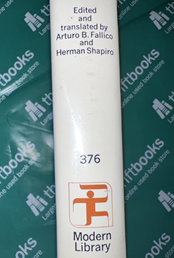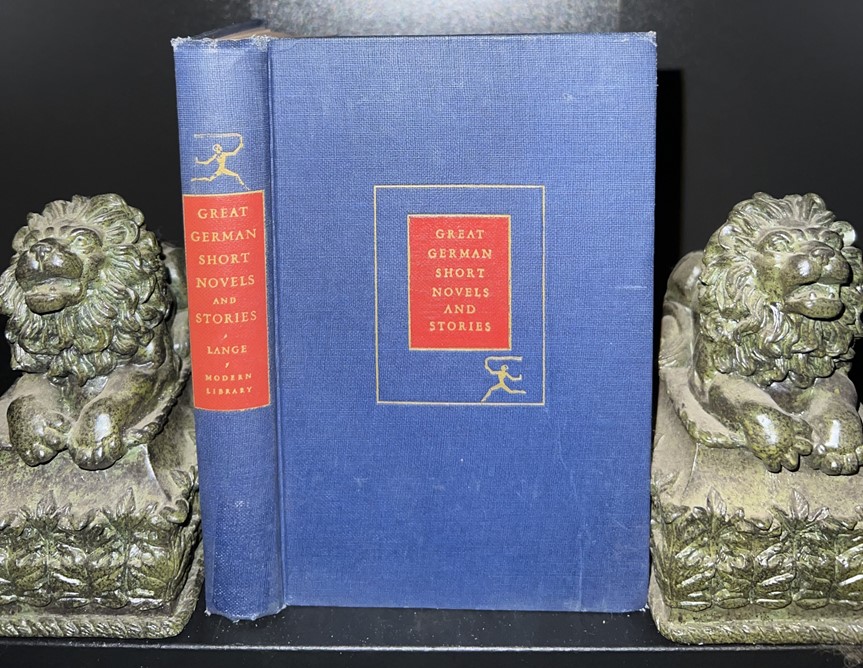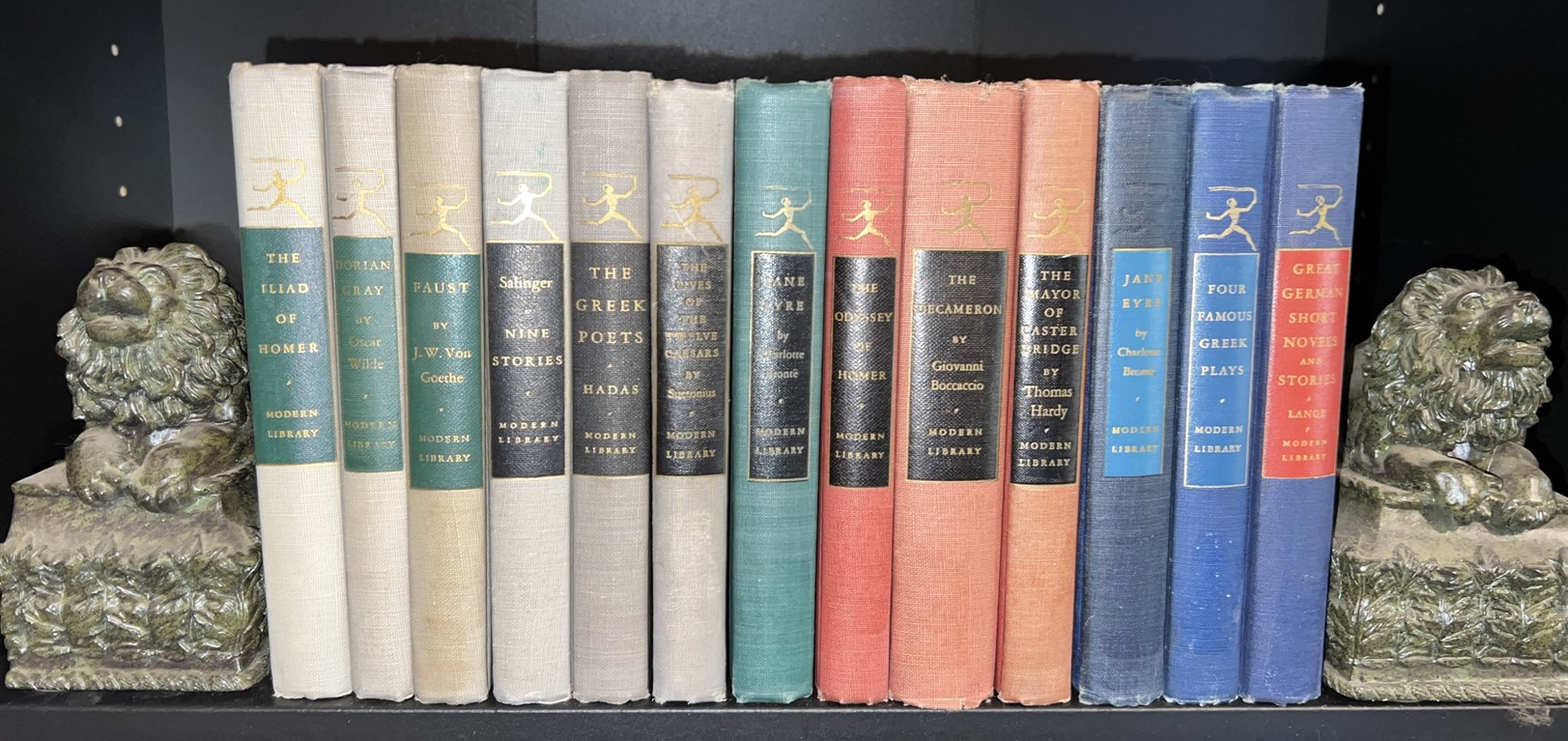Some Ways of Collecting the Modern Library
By Phillip Caprara • June 10, 2022
Beginning a collection of Modern Library books can seem daunting. With so many titles and formats to choose from, it is easy to get lost! Even once a title is selected, choices still must be made about the binding style and the dust jacket. Which binding style do you prefer? Is a flexible or a stiff binding better? Do you even want a dust jacket? All these questions must be answered in one way or another when adding a Modern Library book to your collection. Many people organize their collections by author, title, or genre, the way other series are collected. But the unique qualities of Modern Library books allow for even more creative organization methods.
In this blog, I discuss three ways that Modern Library collections can be organized based on whether the volume is clothed (with a dust jacket) or naked (lacking a dust jacket). Since, by and large, people prefer to collect clothed copies of Modern Library editions, an extremely common means of organizing is by using what's called a Toledano Number. If naked volumes are preferred, it is the binding styles which are showcased. Such collections are usually either diachronic sets that showcase how the series evolved or single binding style sets that highlight a specific moment in history. Along the way, I'll discuss some history of the series as well as some of the benefits and drawbacks of each type of collection.
Let's begin with what is probably the most common organization method: the Toledano Number.
 A small number printed on the spine of every Modern Library dust jacket from 1917 until 1975, the Toledano Number is, by far, the most common way that clothed Modern Library volumes are organized. Sometimes these numbers are preceded by a "C," "G," "P,"; or "T" for "Chronicles," "Giant," "Paperback," and "College" editions. Although no two titles were ever printed with the same number at the same time, several titles did eventually share a Toledano number for one reason or another; number 90, for example, is shared by three titles with slight differentiation between them: Marius the Epicurean (90.1), Catcher in the Rye (90.2), and Four Contemporary French Plays (90.3). A collection organized by Toledano Number will arrange titles as they were published by the Modern Library. Such a collection takes advantage of the often beautifully designed dust jackets and can showcase the changing tastes represented by the evolving catalogue of titles. A drawback of the Toledano Number system is its reliance on dust jackets. Without the dust jacket, one must turn to pricing guides or internet resources to identify the Toledano Number and the book's place in the series. Another drawback is that dust jackets increase the price of the book, sometimes rendering older volumes rather expensive compared to others (as with Anatole France's The Revolt of the Angels). Despite these drawbacks, many collectors still enjoy the beautiful dust jackets, and so use the Toledano Numbers to organize their collections. There is a growing number of collectors, however, who prefer the book to be naked, without a dust jacket.
A small number printed on the spine of every Modern Library dust jacket from 1917 until 1975, the Toledano Number is, by far, the most common way that clothed Modern Library volumes are organized. Sometimes these numbers are preceded by a "C," "G," "P,"; or "T" for "Chronicles," "Giant," "Paperback," and "College" editions. Although no two titles were ever printed with the same number at the same time, several titles did eventually share a Toledano number for one reason or another; number 90, for example, is shared by three titles with slight differentiation between them: Marius the Epicurean (90.1), Catcher in the Rye (90.2), and Four Contemporary French Plays (90.3). A collection organized by Toledano Number will arrange titles as they were published by the Modern Library. Such a collection takes advantage of the often beautifully designed dust jackets and can showcase the changing tastes represented by the evolving catalogue of titles. A drawback of the Toledano Number system is its reliance on dust jackets. Without the dust jacket, one must turn to pricing guides or internet resources to identify the Toledano Number and the book's place in the series. Another drawback is that dust jackets increase the price of the book, sometimes rendering older volumes rather expensive compared to others (as with Anatole France's The Revolt of the Angels). Despite these drawbacks, many collectors still enjoy the beautiful dust jackets, and so use the Toledano Numbers to organize their collections. There is a growing number of collectors, however, who prefer the book to be naked, without a dust jacket.
Because older dust jackets are becoming more difficult to find and because the presence of a dust jacket usually increases a book's price, more and more collectors are starting to showcase naked Modern Library volumes. These collections take advantage of the fact that dust jackets are often separated from their volumes as the objects pass through different hands. For most Modern Library titles, there are two or three times the quantity of naked volumes available as clothed ones. Pursuing naked volumes is also a more economic option. It is almost universally the case that a Modern Library book lacking its dust jacket is cheaper than one with its dust jacket. This can sometimes mean that even the oldest titles from before the 1920's can be less than $10.00. While there are any number of ways to go about collecting these naked volumes, many collectors either strive to create a diachronic set to showcase binding materials or choose to specialize in a specific binding, like the Blumenthal bindings.
Many Modern Library collectors prefer to showcase the variety and evolution of the Modern Library's binding styles in diachronic sets. In such collections, dust jackets are not considered important, and titles can be repeated, as the purpose is to showcase the gradual change over the life of the series. Oftentimes, these collections are arranged chronologically according to the binding material: leatherette, balloon-cloth, book-cloth, buckram, and paper. The earliest titles, published from 1917-1929, are bound in flexible leatherette with artificial grain designed to replicate the look and feel of leather (as with Latzko's Men in War). Beginning in January of 1929, the bindings underwent a transitionary phase where flexible balloon-cloth replaced the leatherette (see Proust's Cities of the Plain for an example). This balloon-cloth remained in use for a decade, going through several distinct styles, until eventually being replaced by linen-book cloth around stiff book boards in 1939 (Antic Hay). Once linen was introduced, it became the standard binding material for all Modern Library volumes, regular and giant. While buckram copies were occasionally made (such as for the special editions of Faulkner's Sanctuary and Go Down, Moses), by and large it was linen book-cloth bound copies that were produced. It wasn't until 1977 that red-brown paper replaced book-cloth as the preferred binding material (as with The European Philosophers). This would remain the standard until the early 1990's when the modern library temporarily ended before being reborn in its present state in 1992. One benefit of organizing a collection by binding material is the wealth of options available for purchase. Because the binding material, not the title is what's important, a collector can choose the best quality book for the lowest price without almost ever feeling limited in their range of selections. While collections like this highlight the evolution of the series, they can be difficult to complete. Titles printed before the transition to hardback in 1939 are not only scarce, but also are likely to have suffered some form of degradation simply because of their age. Because of these drawbacks, some collectors eschew showcasing the variety of binding materials in favor of specializing in one, more easily obtained, binding style.
 Collectors who seek out a single binding style most often focus on a later style binding, one from after 1939 (The Fall and Exile & the Kingdom or Napoleon). There are simply more of these titles available, both because their hardback bindings enhanced their durability and because later binding styles were used for decades, rather than a few months or years. The array of titles and binding styles available allows a collector to select the color and material that suits them best. The style which one most often sees is called Style 8, also known as Blumenthal bindings. Named after their designer, Joseph Blumenthal, these marked a major transition for the series. Red (Best Plays of Chekhov), blue (Benjamin Franklin's Authobiography), green (The Bostonians), and gray (Sister Carrie) linen book-cloth was used beginning in 1939, and these colors remained in use until 1962. Not only were the titles published with this cloth the first Modern Library books to use book-cloth, but they were also the first to use non-flexible book boards. This gave the volumes a stability, durability, and visual appeal that had previously been lacking. To further enhance the volumes, topstains were added and the iconic "torchbearer" was placed on the spine as well as the front cover. The tradition of using gold lettering for the title on the spine continued; this time, however, the title was stamped onto a contrasting color panel surrounded by a gold frame. The same contrasting color panel with the gold-lettered title also sits in the center of the front cover. In addition to the heightened aesthetic value, these design changes resulted in volumes with longer life spans than their predecessors. This has allowed titles published in the early 1940's to survive much better than those published just a few years prior. One drawback to this type of collection, because people usually collect hardbound volumes, is that it omits some of the earliest titles published in the series; dozens of titles published during the early years never made the transition to hardback binding.
Collectors who seek out a single binding style most often focus on a later style binding, one from after 1939 (The Fall and Exile & the Kingdom or Napoleon). There are simply more of these titles available, both because their hardback bindings enhanced their durability and because later binding styles were used for decades, rather than a few months or years. The array of titles and binding styles available allows a collector to select the color and material that suits them best. The style which one most often sees is called Style 8, also known as Blumenthal bindings. Named after their designer, Joseph Blumenthal, these marked a major transition for the series. Red (Best Plays of Chekhov), blue (Benjamin Franklin's Authobiography), green (The Bostonians), and gray (Sister Carrie) linen book-cloth was used beginning in 1939, and these colors remained in use until 1962. Not only were the titles published with this cloth the first Modern Library books to use book-cloth, but they were also the first to use non-flexible book boards. This gave the volumes a stability, durability, and visual appeal that had previously been lacking. To further enhance the volumes, topstains were added and the iconic "torchbearer" was placed on the spine as well as the front cover. The tradition of using gold lettering for the title on the spine continued; this time, however, the title was stamped onto a contrasting color panel surrounded by a gold frame. The same contrasting color panel with the gold-lettered title also sits in the center of the front cover. In addition to the heightened aesthetic value, these design changes resulted in volumes with longer life spans than their predecessors. This has allowed titles published in the early 1940's to survive much better than those published just a few years prior. One drawback to this type of collection, because people usually collect hardbound volumes, is that it omits some of the earliest titles published in the series; dozens of titles published during the early years never made the transition to hardback binding.
 These are not the only ways to organize a collection of Modern Library books, but they are some of the most common. Since every volume has one, and because they are universally understood among serious collectors, Toledano Numbers are an excellent way to organize a collection of clothed Modern Library books. This also takes advantage of the beautiful dust jackets. But the reliance on dust jackets means that many older titles will not have a place in the collection because their dust jackets do not survive, and those that do can often fetch a high price. The collector of naked Modern Library volumes often chooses to organize their collection diachronically; they want to highlight how the series evolved by showcasing the variety of binding materials and styles. The collector of a single binding style instead chooses the style they find most attractive; their collection serves as a monument to the unique features of that binding style.
These are not the only ways to organize a collection of Modern Library books, but they are some of the most common. Since every volume has one, and because they are universally understood among serious collectors, Toledano Numbers are an excellent way to organize a collection of clothed Modern Library books. This also takes advantage of the beautiful dust jackets. But the reliance on dust jackets means that many older titles will not have a place in the collection because their dust jackets do not survive, and those that do can often fetch a high price. The collector of naked Modern Library volumes often chooses to organize their collection diachronically; they want to highlight how the series evolved by showcasing the variety of binding materials and styles. The collector of a single binding style instead chooses the style they find most attractive; their collection serves as a monument to the unique features of that binding style.
Regardless of how you organize your Modern Library collection, do it in the way that showcases what you find most attractive and most fascinating. Highlight the features that you believe make these books worthy of being part of your collection.


